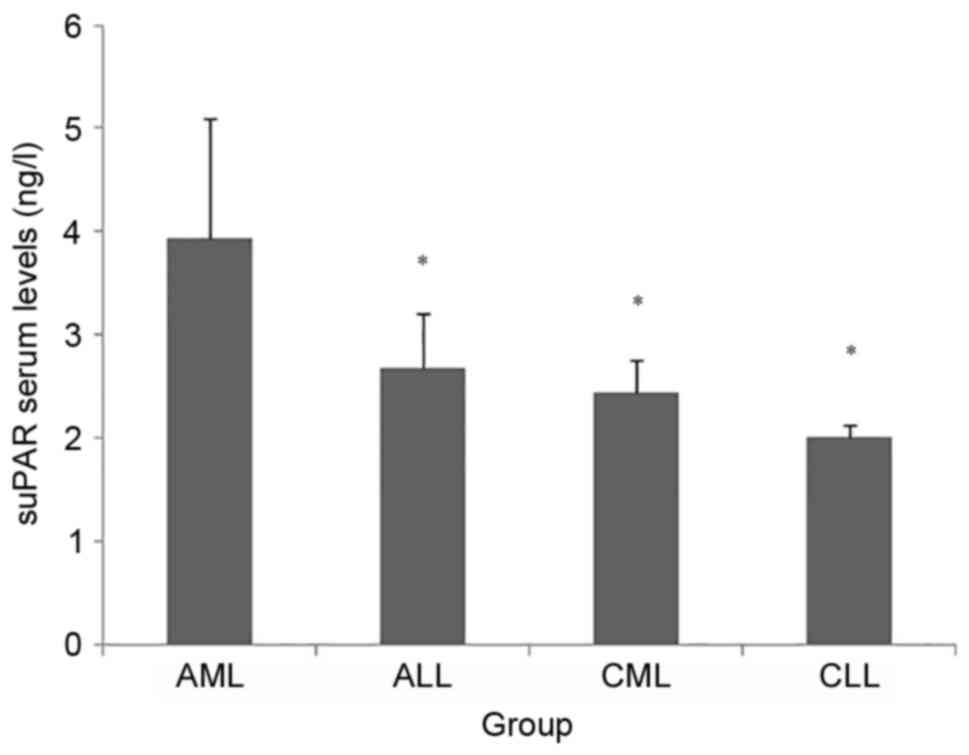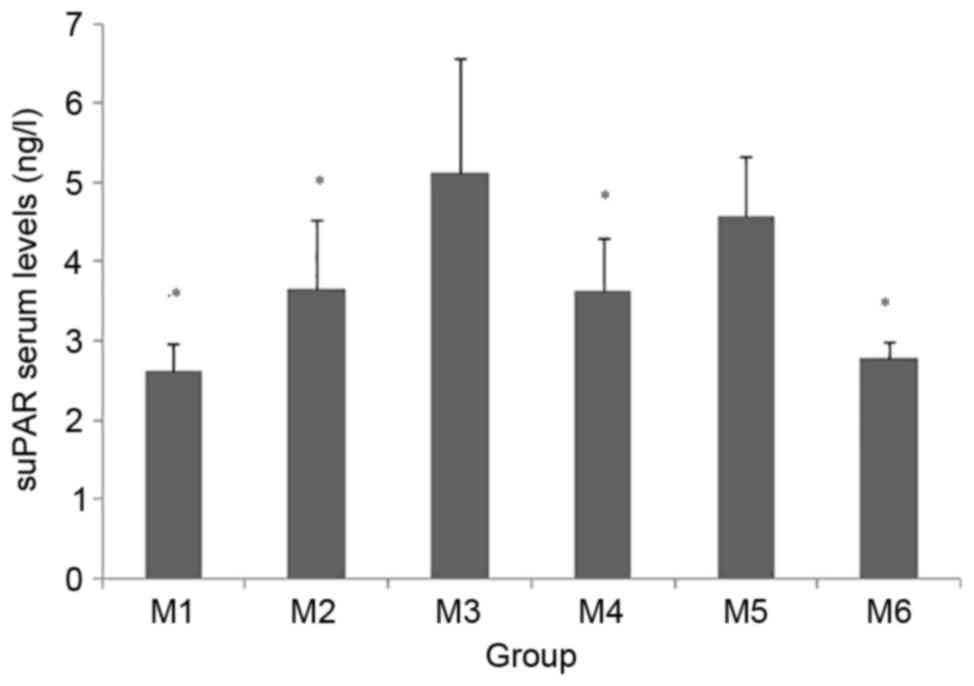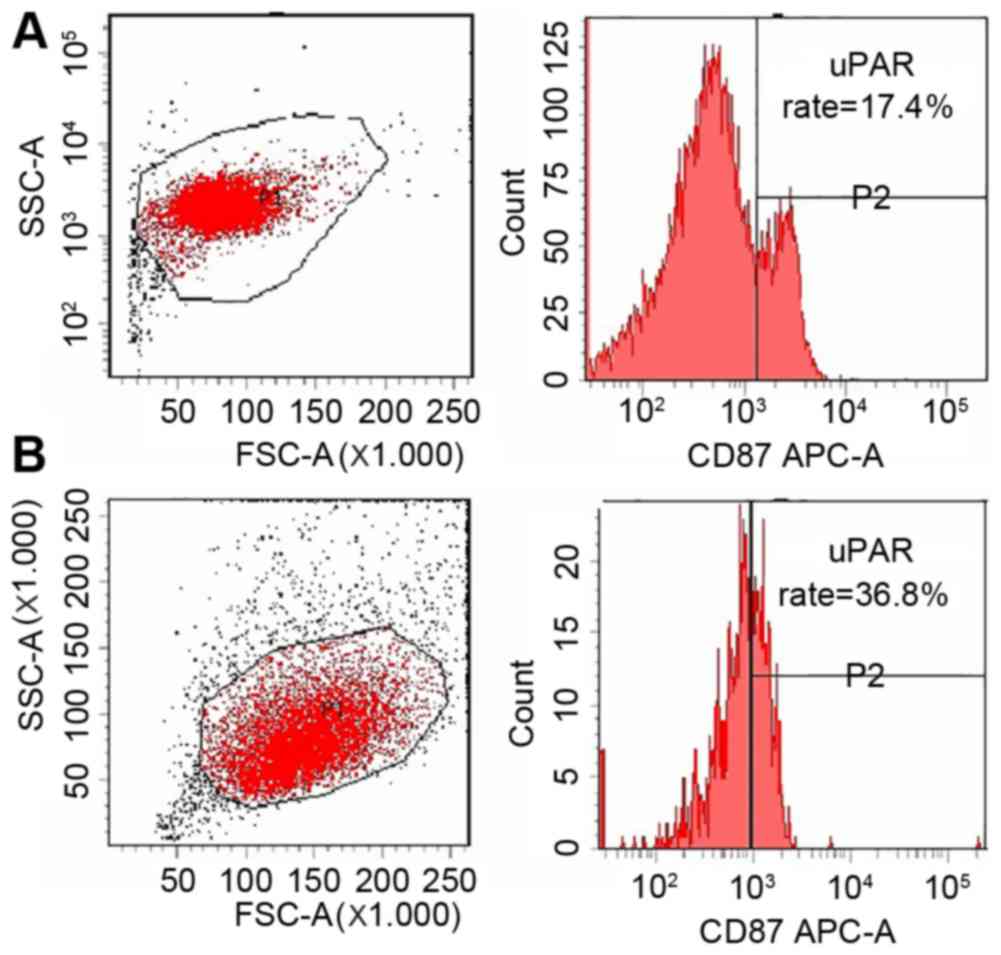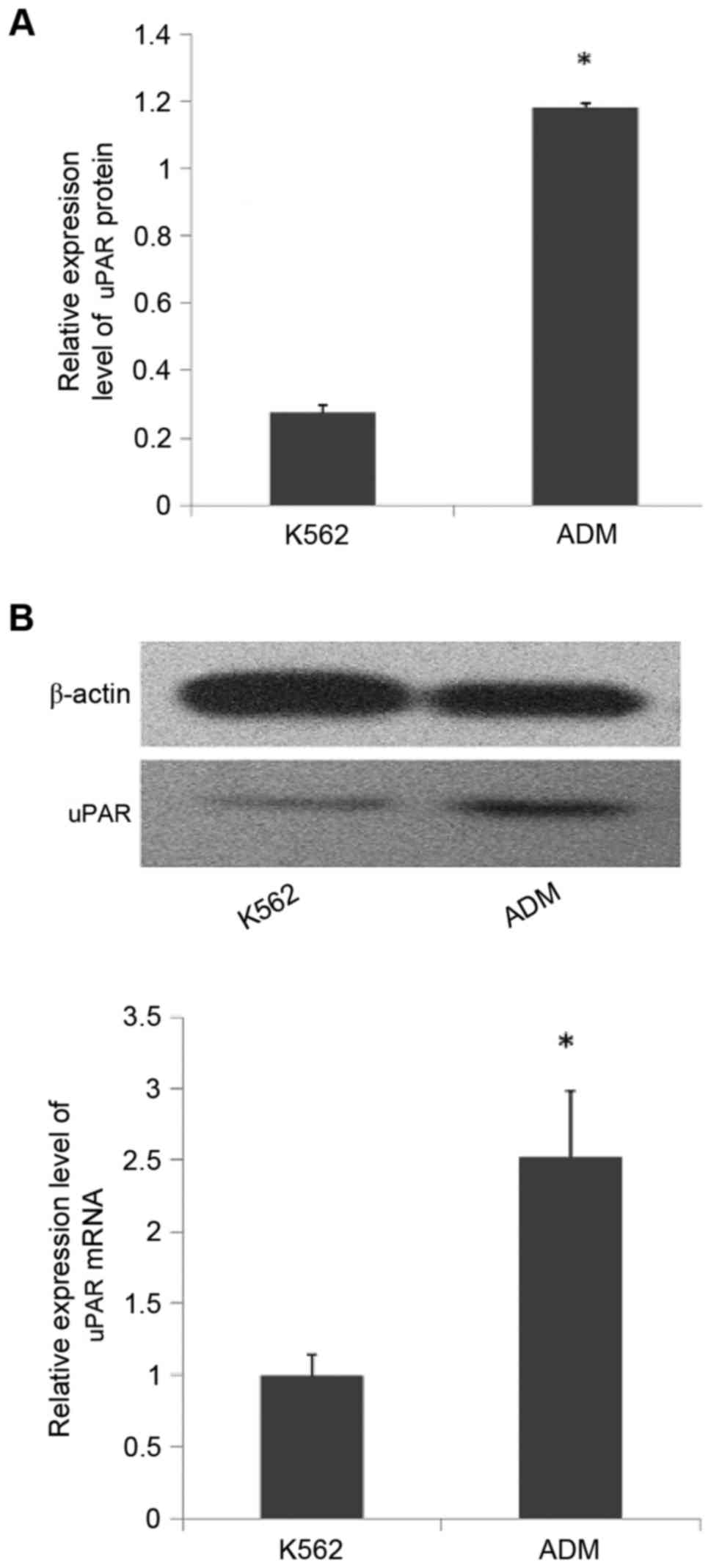|
1
|
Montuori N and Ragno P: Multiple
activities of a multifaceted receptor: Roles of cleaved and soluble
uPAR. Front Biosci (Landmark Ed). 14:2494–2503. 2009. View Article : Google Scholar : PubMed/NCBI
|
|
2
|
Rønne E, Pappot H, Grøndahl-Hansen J,
Høyer-Hansen G, Plesner T, Hansen NE and Danø K: The receptor for
urokinase plasminogen activator is present in plasma from healthy
donors and elevated in patients with paroxymal nocturnal
haemoglobinuria. Br J Haematol. 89:576–581. 1995. View Article : Google Scholar : PubMed/NCBI
|
|
3
|
Stephens RW, Pedersen AN, Nielsen HJ,
Hamers MJ, Høyer-Hansen G, Rønne E, Dybkjaer E, Danø K and Brünner
N: ELISA determination of soluble urokinase receptor in blood from
healthy donors and cancer patients. Clin Chem. 43:1868–1876.
1997.PubMed/NCBI
|
|
4
|
Donadello K, Scoletta S, Covajes C and
Vincent JL: suPAR as a prognostic marker in sepsis. BMC Med.
10:22012. View Article : Google Scholar : PubMed/NCBI
|
|
5
|
Tzanakaki G, Paparoupa M, Kyprianou M,
Barbouni A, Eugen-Olsen J and Kourea-Kremastinou J: Elevated
soluble urokinase receptor values in CSF, age and bacterial
meningitis infection are independent and additive risk factors of
fatal outcome. Eur J Clin Microbiol Infect Dis. 31:1157–1162. 2012.
View Article : Google Scholar : PubMed/NCBI
|
|
6
|
Yılmaz G, Köksal I, Karahan SC and Mentese
A: The diagnostic and prognostic significance of soluble urokinase
plasminogen activator receptor in systemic inflammatory response
syndrome. Clin Biochem. 44:1227–1230. 2011. View Article : Google Scholar : PubMed/NCBI
|
|
7
|
Enocsson H, Sjöwall C and Wetterö J:
Soluble urokinase plasminogen activator receptor-a valuable
biomarker in systemic lupus erythematosus? Clin Chim Acta.
444:234–241. 2015. View Article : Google Scholar : PubMed/NCBI
|
|
8
|
Toldi G, Bekő G, Kádár G, Mácsai E, Kovács
L, Vásárhelyi B and Balog A: Soluble urokinase plasminogen
activator receptor (suPAR) in the assessment of inflammatory
activity of rheumatoid arthritis patients in remission. Clin Chem
Lab Med. 51:327–332. 2013. View Article : Google Scholar : PubMed/NCBI
|
|
9
|
Eugen-Olsen J, Andersen O, Linneberg A,
Ladelund S, Hansen TW, Langkilde A, Petersen J, Pielak T, Møller
LN, Jeppesen J, et al: Circulating soluble urokinase plasminogen
activator receptor predicts cancer, cardiovascular disease,
diabetes and mortality in the general population. J Intern Med.
268:296–308. 2010. View Article : Google Scholar : PubMed/NCBI
|
|
10
|
Toldi G, Bíró E, Szalay B, Stenczer B,
Molvarec A, Rigó J, Vásárhelyi B and Bekõ G: Soluble urokinase
plasminogen activator receptor (suPAR) levels in healthy pregnancy
and preeclampsia. Clin Chem Lab Med. 49:1873–1876. 2011. View Article : Google Scholar : PubMed/NCBI
|
|
11
|
Ivancsó I, Toldi G, Bohács A, Eszes N,
Müller V, Rigó J Jr, Vásárhelyi B, Losonczy G and Tamási L:
Relationship of circulating soluble urokinase plasminogen activator
receptor (suPAR) levels to disease control in asthma and asthmatic
pregnancy. PLoS One. 8:e606972013. View Article : Google Scholar : PubMed/NCBI
|
|
12
|
Odden N, Henriksen T and Mørkrid L: Serum
soluble urokinase plasminogen activator receptor (suPAR) in early
pregnancy prior to clinical onset of preeclampsia. Acta Obstet
Gynecol Scand. 91:1226–1232. 2012. View Article : Google Scholar : PubMed/NCBI
|
|
13
|
Pappot H, Høyer-Hansen G, Rønne E, Hansen
HH, Brünner N, Danø K and Grøndahl-Hansen J: Elevated plasma levels
of urokinase plasminogen activator receptor in non-small cell lung
cancer patients. Eur J Cancer. 33:867–872. 1997. View Article : Google Scholar : PubMed/NCBI
|
|
14
|
Høgdall CK, Christensen IJ, Stephens RW,
Sørensen S, Nørgaard-Pedersen B and Nielsen HJ: Serum tetranectin
is an independent prognostic marker in colorectal cancer and weakly
correlated with plasma suPAR, plasma PAI-1 and serum CEA. APMIS.
110:630–638. 2002. View Article : Google Scholar : PubMed/NCBI
|
|
15
|
Begum FD, Høgdall EV, Riisbro R,
Christensen IJ, Engelholm SA, Jørgensen M, Pedersen BN and Høgdall
CK: Prognostic value of plasma soluble urokinase plasminogen
activator receptor (suPAR) in Danish patients with recurrent
epithelial ovarian cancer (REOC). APMIS. 114:675–681. 2006.
View Article : Google Scholar : PubMed/NCBI
|
|
16
|
Ostrowski SR, Piironen T, Høyer-Hansen G,
Gerstoft J, Pedersen BK and Ullum H: High plasma levels of intact
and cleaved soluble urokinase receptor reflect immune activation
and are independent predictors of mortality in HIV-1-infected
patients. J Acquir Immune Defic Syndr. 39:23–31. 2005. View Article : Google Scholar : PubMed/NCBI
|
|
17
|
Wittenhagen P, Kronborg G, Weis N, Nielsen
H, Obel N, Pedersen SS and Eugen-Olsen J: The plasma level of
soluble urokinase receptor is elevated in patients with
Streptococcus pneumoniae bacteraemia and predicts mortality. Clin
Microbiol Infect. 10:409–415. 2004. View Article : Google Scholar : PubMed/NCBI
|
|
18
|
Koch A, Voigt S, Kruschinski C, Sanson E,
Dückers H, Horn A, Yagmur E, Zimmermann H, Trautwein C and Tacke F:
Circulating soluble urokinase plasminogen activator receptor is
stably elevated during the first week of treatment in the intensive
care unit and predicts mortality in critically ill patients. Crit
Care. 15:R632011. View
Article : Google Scholar : PubMed/NCBI
|
|
19
|
Rabna P, Andersen A, Wejse C, Oliveira I,
Gomes VF, Haaland MB, Aaby P and Eugen-Olsen J: High mortality risk
among individuals assumed to be TB-negative can be predicted using
a simple test. Trop Med Int Health. 14:986–994. 2009. View Article : Google Scholar : PubMed/NCBI
|
|
20
|
Haupt TH, Petersen J, Ellekilde G, Klausen
HH, Thorball CW, Eugen-Olsen J and Andersen O: Plasma suPAR levels
are associated with mortality, admission time, and Charlson
Comorbidity Index in the acutely admitted medical patient: A
prospective observational study. Crit Care. 16:R1302012. View Article : Google Scholar : PubMed/NCBI
|
|
21
|
Mustjoki S, Alitalo R, Stephens RW and
Vaheri A: Blast cell-surface and plasma soluble urokinase receptor
in acute leukemia patients: Relationship to classification and
response to therapy. Thromb Haemost. 81:705–710. 1999.PubMed/NCBI
|
|
22
|
Graf M, Reif S, Hecht K, Pelka-Fleischer
R, Pfister K and Schmetzer H: High expression of urokinase
plasminogen activator receptor (UPA-R) in acute myeloid leukemia
(AML) is associated with worse prognosis. Am J Hematol. 79:26–35.
2005. View Article : Google Scholar : PubMed/NCBI
|
|
23
|
Livak KJ and Schmittgen TD: Analysis of
relative gene expression data using real-time quantitative PCR and
the 2(−Delta Delta C(T)) method. Methods. 25:402–408. 2001.
View Article : Google Scholar : PubMed/NCBI
|
|
24
|
Gutova M, Najbauer J, Gevorgyan A, Metz
MZ, Weng Y, Shih CC and Aboody KS: Identification of uPAR-positive
chemoresistant cells in small cell lung cancer. PLoS ONE.
2:e2432007. View Article : Google Scholar : PubMed/NCBI
|
|
25
|
Lomholt Af, Christensen IJ, Hoyer-Hansen G
and Nielsen HJ: Prognostic value of intact and leaved formof the
urokinase plasminogen activator receptor in a rettospective study
of 518 coloreta cancer patients. Act Oncol. 49:805–811. 2010.
View Article : Google Scholar
|
|
26
|
Kjellaman A, Akre O, Gustafsson O, Hansen
GH, Lilja H, Norming U, Piironen T and Törnblom M: Soluble
urokinase plasminogen activator receptor as prognositic marker in
men participating in prostate cancer rescreening. J Intern med.
269:299–305. 2011. View Article : Google Scholar : PubMed/NCBI
|
|
27
|
Kaya S, Köksal I, Menteşe A, Sönmez M,
Sümer A, Yıldırım SS and Yılmaz G: The significance of serum
urokinase plasminogen activation receptor (suPAR) in the diagnosis
and follow-up of febrile neutropenic patients with hematologic
malignancies. Int J Infect Dis. 17:e1056–e1059. 2013. View Article : Google Scholar : PubMed/NCBI
|
|
28
|
Jardí M, Inglés-Esteve J, Burgal M,
Azqueta C, Velasco F, López-Pedrera C, Miles LA and Félez J:
Distinct patterns of urokinase receptor (uPAR) expression by
leukemic cells and peripheral blood cells. Romb Haemost.
76:1009–1019. 1996.
|

















